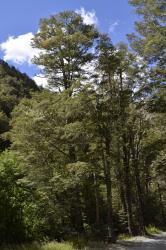- = Nothofageae Baum.-Bod., Syst. Fl. Neu-Caledonien 104 (1992)
- = Fagaceae subfamily Nothofagoideae P.L.Wang & F.T.Pu, Pollen Morphol. & Biogeogr. Fagac. 116 (2004)
Trees or shrubs. Monoecious. Evergreen or deciduous. Leaves, distichous, revolute when evergreen or plicate when deciduous. Stipules present, attached basally or peltate, with point of attachment associated with elongate colleters, caducous. Leaf lamina simple, pinnately veined, entire, crenate, dentate or serrate; minor leaf veins without phloem transfer cells; cuticle usually with globular glandular trichomes. Inflorescence a dichasium. Male inflorescence sessile to shortly pedunculate 1–3-flowered or a pseudanthium; perianth campanulate. Androecium 6–36 stamens; filaments long and flexible; anthers basifixed, elongate, with distal connective protrusion, proximal lobes above the point of connection, non-versatile, tetrasporangiate, dehiscing by a slit. Pollen oblate to peroblate; exine thin, with granular bacules, and small, widely spaced projections; regular foot layer and tectum; colpi 3–10, usually with raised margins. Female inflorescence sessile or shortly pedunculate, usually 3-flowered with 2 lateral trimerous flowers and 1 central dimerous flower; dichasium subtended by a cupule; perianth reduced to a minute rim. Cupule 2–4-valved, valves free throughout development, with lamellar or stalked appendages. Gynoecium: ovary inferior, 3- or 2-carpellate, each carpel with 2 pendulous anatropous ovules; ovules unitegmic; styles as many as carpels, stigmas clavate or linguiform, decurrent or weakly decurrent, glabrous, persistent. Fruit a nut, triquetrous or lenticular, 2- or 3-winged; endocarp glabrous. Cotyledons plicate, with fat reserve; endosperm absent; germination epigeal. Chromosome number n = 13.
Previously, New Zealand species have been placed in either Fagus (Hooker 1852–1853, 1864, Cheeseman 1906) or Nothofagus s.l. (Blume 1851; Cheeseman 1925; Allan 1961) in the Fagaceae. Molecular studies showed that Nothofagus is sister to the entire Fagales (Manos & Steele 1997; Li et al. 2004; Sauquet et al. 2012) and rejected a close relationship with Fagaceae, and in particular a sister group relationship between Fagus and Nothofagus (Kubitzki 1993). Morphological and anatomical studies (Crepet & Daghlian 1980; Nixon 1982, 1989; Jones 1986; Zheng et al. 1999; Li et al. 2004) also support the recognition of Nothofagaceae (Kuprianova 1962).
Earlier infrageneric classifications of Nothofagus s.l. (Steenis 1953; Philipson & Philipson 1988) based on morphology were constructed with characters that were shown to be phylogenetically uninformative; leaf vernation, deciduous or evergreen habit, and cupule valve number were convincingly argued to be the result of parallel evolution (Hill & Read 1991; Hill & Jordan 1993). A phenetic analysis by Hill & Read (1991), based on cuticular morphology, leaf morphology (including hairs and stomata) and leaf architecture, resulted in their subdividing Nothofagus s.l. into four subgenera consistent with the four pollen groups of extant Nothofagaceae (Cranwell 1939; Cookson 1952; Cookson & Pike 1955; Dettmann et al. 1990), i.e., brassii-type, fusca a-type, fusca b-type, and menziesii-type. A molecular analysis using the rbcL gene (Martin & Dowd 1993) provided strong support for four lineages equating to their subgenera. Subsequent DNA sequence analyses (Manos 1997; Setoguchi et al. 1997; Sauquet et al. 2012) have confirmed monophyly and the relationships among the lineages recovered by Martin & Dowd (1993).
Heenan & Smissen (2013) in new analyses using mainly the morphological data of Jordan & Hill (1999) and the published tree of Sauquet et al. (2012), showed that the four clades of Nothofagaceae are robust and well supported, with deep stem divergences, have evolutionary equivalence with other genera of Fagales, and can be circumscribed with morphological characters. They argued that these morphological and molecular differences are sufficient for recognition at the primary rank of genus, and that this classification is more informative and efficient than Nothofagus s.l. with four subgenera. They re-circumscribed Nothofagus s.l. to include five species from southern South America, reinstated Lophozonia and Trisyngyne, and described a new genus, Fuscospora.
Family and generic descriptions presented here are based on the New Zealand species and are therefore more narrowly circumscribed than those in Heenan & Smissen (2013), who provided family and generic descriptions based on the entire range of variation in Nothofagaceae. For Antarctic beech (Nothofagus antarctica), not native to New Zealand, specimens for measurements were taken from two sites where naturalisation has occurred; some of these most likely include original planted trees as well as wildling trees.
| 1 | Leaves with solitary unicellular trichome type C present; perianth open and broadly campanulate; staminate perianth with 6–14 lobes; stamen development pseudocentrifugal, usually >20 stamens; cupule appendages stalked and glandular | Lophozonia |
| Leaves with solitary unicellular trichome type C absent; perianth campanulate; staminate perianth with 0–4 lobes; stamen development centripetal, usually <20 stamens; cupule appendages lamellate | 2 | |
| 2 | Evergreen, leaf vernation revolute; lamina margin entire or 1-serrate; leaves with unicellular trichome type A present | Fuscospora |
| Deciduous, leaf vernation plicate; lamina margin double-serrate; leaves with unicellular trichome type A absent | Nothofagus |
Nothofagaceae comprise monoecious, evergreen or deciduous forest trees, with simple leaves and peltate or non-peltate stipules; male dichasia are small clusters of 1–3 campanulate flowers of yellow, orange or dark red stamens; the female dichasium is a cluster of 2–3 flowers, sometimes 1-flowered, the cluster subtended by a valvate cupule that becomes woody with maturity.
Four genera and 42 species of the Southern Hemisphere; temperate New Zealand, Australia, South America, tropical Indonesia (West Papua), Papua New Guinea (incl. New Britain and D'Entrecasteaux Islands) and New Caledonia.
| Category | Number |
|---|---|
| Indigenous (Endemic) | 5 |
| Exotic: Casual | 1 |
| Total | 6 |




